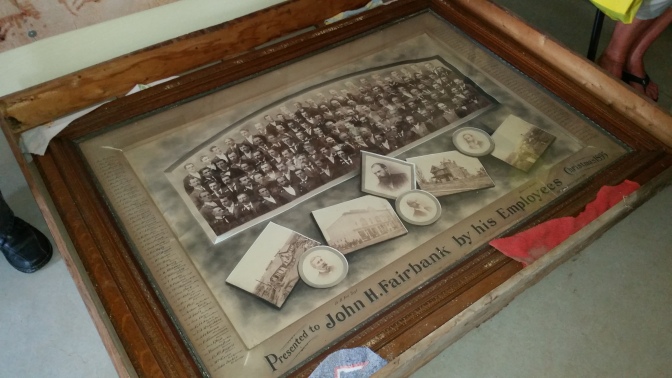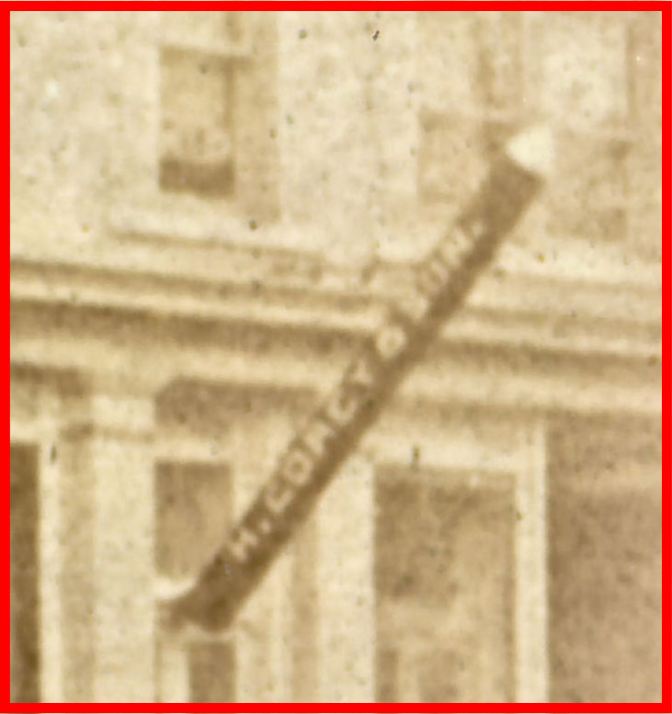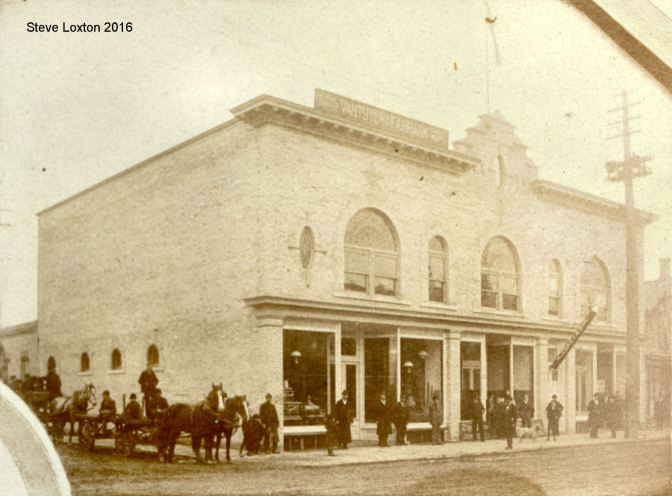As many know, Charlie Fairbank and his wife, Pat McGee are Petrolia150 partners and financial supporters. Last year, their Van Tuyl and Fairbank Hardware, one of Canada’s oldest hardware stores, celebrated its own sesquicentennial.
During the store’s anniversary open house last July, I partook – along with hundreds of others – in a tour through the sprawling and labyrinthine store, which is as much a living museum as a place of business.
Among countless other artifacts, curiosities and images collected over the course of 150 years of business, they had on display a very large framed picture that couldn’t help but catch my eye.

There on the floor, obviously brought from its usual place of honour and laid out for the public to gaze upon, was a venerable sepia toned image, at least six feet wide, in an ancient oversized frame.
The picture was a group photo of over one hundred of John Henry Fairbank’s employees, presented by them to him, for Christmas of 1895; the same year that the new brick store on Petrolia Street was built and opened.
Underneath the large group photo of employees, their boss J. H. Fairbank holds the central place of honour in a lozenge shaped matting. His son and heir, Charles O. Fairbank is right below him and two of his partners, B. S. Van Tuyl and Samuel Rogers flank him. Interspersed among them, four images, including the newly built Fairbank mansion – Sunnyside – and three of his places of business at that time.
When I grabbed a quick snapshot of this evocative piece of Petrolia history, there were parts of the image I wanted a closer look at; like all those names of the employees and the four inset images, that I was pretty sure I’d never seen before. But, the light was poor, the crowds pressing through and this tour was not going to present the opportunity I sought.
Fast forward to the spring of 2016 and the Petrolia150 Facebook group is eliciting the sharing of historical content at a rate and a variety that I could have only dreamed of when it was launched in February.
Last week, Cathy Scott Wagner posted a copy of this image on the Facebook group. At first, I just assumed it was a copy out of some booklet, or other historic publication. But, I was soon to learn that Cathy’s copy was an original card backed print of an unusually large size for its type (about 11 x 17 inches). She had purchased it at a flea market, or some such, for – get this – a quarter!
She conjectures – and I tend to concur – that her copy is one of those made at the same time the giant sized version was produced. These smaller copies were likely given to the other managers, or to other employees who had contributed to its production.
And what an amazing production it was!
Cathy brought this amazing artifact to the Lambton County Archives for me to scan. While her copy has some water damage and shows its age, the superior material quality typical of card backed prints of the era, which contributes to their survivability and value, was readily apparent.

I love these card backed photos because you will not find a photographic print with finer detail. The fact that they were able to produce a razor sharp enlargement close to six feet wide from a glass plate negative that was smaller than a sheet of paper is a testament to their detail. It was a level of quality that was to largely disappear, as glass negatives were replaced by celluloid films and by snapshots from cheap Kodak Brownie cameras.
But, this particular picture is much more than just a typical exposure from a large format, box camera. First of all, this image is a fairly rare, 120 year old example of a 19th century cut and paste job. We do this routinely with Photoshop, today. But, the “cut and paste” in this image was literal, not virtual.
Every head shot in this image was taken separately and then carefully cut out and pasted with others to create a group portrait of over 100 employees. It must have been a labour intensive process. The work is meticulous, resulting in a skillfully rendered work of art, that was the state-of-the-art of its time.

Secondly, while all photographic prints of this period are historic artifacts, in their own right, and the images they capture important historic documents, this image contains an almost overwhelming amount of unique historic content.
Among other things, it’s a family historian’s dream come true. Every one of the 100+ employee portraits is numbered and matched with the subject’s name and where he worked for the Fairbank organization.

Would you like to see if your ancestor is included in the group photo? I’ve transcribed every name in a database listing, available here.
Then, we have the four inset images, showing scenes connected with Fairbank and his business empire. While the subjects have been captured before – some many times over, such as the Fairbank mansion – I’ve never seen any of these specific images before. As far as I know, the originals are lost and it’s only through this period montage that they have been preserved.
It’s worth examining these inset images in detail. This is where the phenomenally fine resolution of a card backed print is truly revealed. I was able to scan these inset pictures, whose size in Cathy’s copy were smaller than a business card, at a resolution that enlarged all their fantastic details up to poster size!

At a resolution of 2400 dots per inch (dpi), the tiny red square (above right) ends up resolving to this:

And with that, we can now see that Harrison Corey & Son occupied part of the new Fairbank block.
Note: What is that thing that their name is painted upon? I believe that it is a replica of an oil well torpedo. These were filled with nitro-glycerine and dropped down an oil well to fracture the rock and recover more oil. This was one of Corey’s main lines of business.

This is possibly the earliest known photo of Van Tuyl and Fairbank’s new business block, which was built in 1895, the same year that Fairbank’s employees presented him with their group photo.

Besides the new Fairbank block, there are three other inset photos. One is of Stevenson Boiler and Engine Works. It was taken over by Fairbank in 1890, as its largest creditor, when William Stevenson left town without paying his debts.

There are a few photos of the boiler works extant, including at least one from a similar vantage point. But, this is the only image I’ve seen with so much activity taking place in the yard. We see a number of boilers and vessels in various states of fabrication. There’s a couple of horses, a railway gondola, a hoisting derrick and lots of related equipment; all giving the impression of a busy and thriving business.
My great great grandfather, Elijah Loxton worked for Stevenson when he first came to Petrolia in 1877. I didn’t find him in the employee photo which, while somewhat disappointing, provided some dating information about when he opened his own boiler shop across Centre St., on land purchased from Stevenson.
Elijah’s house is still there; smack in the middle of Petrolia’s industrial zone, today as it was when built, in 1881. I’m sure there’s lots more genealogical tidbits – not to mention, the 100+ portraits – waiting for the descendants of these employees to discover.
Next is an image of a place that might have been impossible to identify, if it weren’t for a single image and some of the names included among Fairbank’s employees.

It turns out that this is now one of only two known photos of M.J. Woodward’s Refinery. It was fortunate that this image was even captured in the Fairbank photo, because he and partner Samuel Rogers*, incorporated under the name Fairbank, Rogers & Company, owned it for only a few short years, from 1892 until 1897, while the Fairbank photo is from 1895.
*Of note, Samuel Rogers was the great grandfather of Ted Rogers, of Rogers Communications fame.
Sure enough (and somewhat characteristic of Fairbank), despite Woodward’s refinery going bankrupt, both Woodward and his son are included in the employee photo; he was likely still managing the place.
I didn’t even know where this refinery was located until our friend, Tom Walter, provided a reference stating that it was on the 12th line (now, Lasalle Ln.), between Petrolia’s two railway lines. Today, most locals will recall the location as a former wrecking yard.
Finally, the fourth inset image is a familiar one, yet still unique. It is also quite possibly the earliest known photo of the Fairbanks’ new mansion, Sunnyside.

While Sunnyside is familiar to all Petrolians and has been captured thousands of times, this image is special in that we see a rare (partial) view of the coach house, in the rear.
Very few views of the mansion include the carriage house and that’s important, because it started out as one of the Fairbanks’ previous homes. It was located at the front of the lot, but was moved to the back (and turned 90 degrees, so that the east facade now faced south) when the mansion was built.
Here’s an amazing high resolution photo of the house, before the mansion was built, from Martin Dillon’s Petrolia Heritage site.
So, there you have it. The Fairbank Employee’s Christmas 1895 montage contains a huge amount of Petrolia history; some of which would have been lost forever, if not preserved by folks like Cathy Scott Wagner.
Which begs the question:
What Petrolia history is hiding in your attic?
Petrolia150 and the Petrolia Heritage Committee will be at the Petrolia Farmers Market grand opening on Saturday, May 28th, 2016 and we want to see your Petrolia related historic photos, scrapbooks, journals, artifacts, curios and curiosities.
We will have our collections out and would like to see yours. We will have a scanner, camera and local history experts ready to document your Petrolia history treasures.
Who knows, maybe your treasures will be featured in a future blog post.
Steve Loxton
April 2016
Hello all,
You’re right Steve, this photo is pretty exceptional and it has quite a history.
We had more than 500 people see it last year when we held the VanTuyl and Fairbank Hardware 150-year Anniversary Tour in July. It was also on view when we unveiled the Solar Windows – Before Oil and After – by artists Geri Binks and Christopher Wallis. That was years earlier.
Thought you’d be interested to know that Charlie loaned this photo to the Town of Petrolia in the early 1990s and it was displayed at Victoria Hall for almost 20 years. For years it hung in the outer lobby, across from the display cases. Later, it was moved to the council chambers and hung there for years. It was taken down, possibly for the room to be painted.
Once the paint was dry it was stored for quite a while at Victoria Hall. We were asked to retrieve it and it was then moved to VanTuyl and Fairbank Solarware.
As you may know, the photo is huge, measuring something like five by four feet and it is also extremely heavy. This size and weight makes it difficult to hang and it is need of repair and that’s why it sits on the floor at VanTuyl and Fairbank Solarware. The fellow who was called to refurbish it never showed up so this remains on the list of things to do.
We believe that dozens of copies of this photo or maybe more were made at the time. It’s possible that each person in the photo had a copy. We really don’t know.
We have two of the smaller versions. One has hung over the safe in the VanTuyl and Fairbank Hardware office longer than anyone can remember and we also have a copy here in Oil springs.
Last year, I spoke to Dana Thorne form the Lambton County Archives about scanning it and I believe she did but I am not certain.
Cheers and thanks….Pat
____________________ Patricia McGee (519) 834-2677 pat.mcgee@ciaccess.com
LikeLike